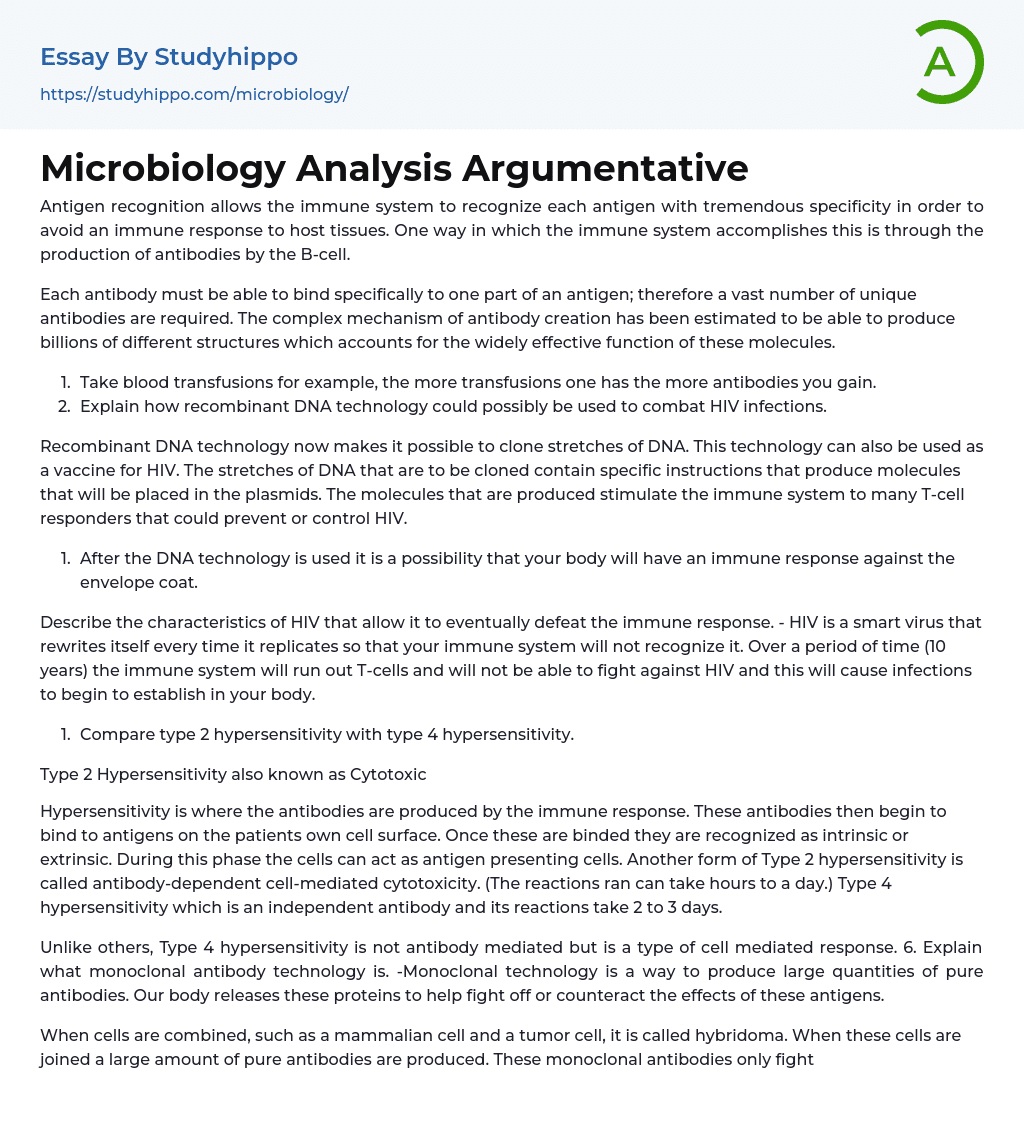Antigen recognition allows the immune system to recognize each antigen with tremendous specificity in order to avoid an immune response to host tissues. One way in which the immune system accomplishes this is through the production of antibodies by the B-cell.
Each antibody must be able to bind specifically to one part of an antigen; therefore a vast number of unique antibodies are required. The complex mechanism of antibody creation has been estimated to be able to produce billions of different structures which accounts for the widely effective function of these molecules.
- Take blood transfusions for example, the more transfusions one has the more antibodies you gain.
- Explain how recombinant DNA technology could possibly be used to combat HIV infections.
Recombinant DNA technology now makes it possible to c
...lone stretches of DNA. This technology can also be used as a vaccine for HIV. The stretches of DNA that are to be cloned contain specific instructions that produce molecules that will be placed in the plasmids. The molecules that are produced stimulate the immune system to many T-cell responders that could prevent or control HIV.
- After the DNA technology is used it is a possibility that your body will have an immune response against the envelope coat.
Describe the characteristics of HIV that allow it to eventually defeat the immune response. - HIV is a smart virus that rewrites itself every time it replicates so that your immune system will not recognize it. Over a period of time (10 years) the immune system will run out T-cells and will not be able to fight against HIV and this will cause infections to begin to establish in your body.
Type 2 Hypersensitivity also known as Cytotoxic
Hypersensitivity is where the antibodies are produced by the immune response. These antibodies then begin to bind to antigens on the patients own cell surface. Once these are binded they are recognized as intrinsic or extrinsic. During this phase the cells can act as antigen presenting cells. Another form of Type 2 hypersensitivity is called antibody-dependent cell-mediated cytotoxicity. (The reactions ran can take hours to a day.) Type 4 hypersensitivity which is an independent antibody and its reactions take 2 to 3 days.
Unlike others, Type 4 hypersensitivity is not antibody mediated but is a type of cell mediated response. 6. Explain what monoclonal antibody technology is. -Monoclonal technology is a way to produce large quantities of pure antibodies. Our body releases these proteins to help fight off or counteract the effects of these antigens.
When cells are combined, such as a mammalian cell and a tumor cell, it is called hybridoma. When these cells are joined a large amount of pure antibodies are produced. These monoclonal antibodies only fight molecules with little or no side effects.
Hybridoma cells are also referred to as a fused hybrid cell because they are able to grow indefinitely in the media. 7. Explain how your immune system avoids a primary immune response to your antigens.
The antigens we have in our body are marked with MHCs. When our immune system recognizes a cell with a MHC marker it does not get attacked. Cells that are not marked with this MHC marker get attacked. Immune memory allows the antibodies to remain in circulation and mark it so that
it will remember it during its next exposure in the future.
- Cloning essays
- Medical Ethics essays
- Patient essays
- Therapy essays
- drugs essays
- Cannabis essays
- Aspirin essays
- Cardiology essays
- Hemoglobin essays
- Pharmacology essays
- Surgery essays
- alternative medicine essays
- Plastic Surgery essays
- Organ Donation essays
- Vaccines essays
- Medical essays
- Dentist essays
- Psychological Trauma essays
- Physical therapy essays
- Cold essays
- Cocaine essays
- Why Marijuana Should Be Legalized essays
- Drug Abuse essays
- Teenage Drug Abuse essays
- Heart Disease essays
- Artery essays
- Birth Control essays
- Drug Addiction essays
- Eating Disorders essays
- Epidemiology essays
- Hiv essays
- Hygiene essays
- Obesity essays
- Social Care essays
- Teenage Pregnancy essays
- Action Potential essays
- Blood essays
- Body essays
- Brain essays
- Childbirth essays
- Eye essays
- Glucose essays
- Heart essays
- Human Physiology essays
- Immune System essays
- Kidney essays
- Muscle essays
- Nervous System essays
- Neuron essays
- Poison essays




